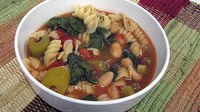Prairie Fare: Size and Color of Plates May Influence Portion Size
(Click an image below to view a high-resolution image that can be downloaded)
By Julie Garden-Robinson, Food and Nutrition Specialist
NDSU Extension Service
The other day, I was looking for my bright red tablecloth to add a little seasonal festivity to our dining room. I began looking for it in a kitchen closet that has multiple removable shelves.
As I peeked under a stack of placemats, the shelf slid out of place, setting off a cascade of tableware that dislodged the other shelves. Soon I was surrounded by dozens of placemats and tablecloths featuring festive turkeys, ghosts, snowmen, fruits and vegetables.
I wasn’t exactly thrilled with the colorful mess I had created. I found the red tablecloth, though.
As I refolded the tablecloths and stacked my placemats, I thought about a study I just read. When we use colorful tablecloths surrounding our plates, are we affecting how much food we serve ourselves?
I usually use our white plates for holiday meals. Do I serve different amounts on my white plates versus the brown ones? My antique white dishes from around 1905 are considerably smaller than my recently purchased plates. Could plate size affect my family’s portion size, too?
Fortunately, someone else did the actual research. A recently published study in the Journal of Consumer Research explored how and why plate and tableware color might affect the amount of food we serve or eat. Researchers Koert Van Ittersum and Brian Wansink set up several experiments to test these theories.
We know from previous studies that using larger bowls and plates often results in people dishing up larger portions for themselves. Eating larger portions means that we are consuming more calories, which can result in larger waistlines and wider hips through time.
Just 100 extra calories per day can add up to a 10-pound weight gain in a year. Being overweight or obesity is linked to diabetes, heart disease, cancer, joint problems and many other health issues.
Many nutrition experts recommend that we use smaller plates, which appear fuller with the same amount of food. The researchers noted that since 1900, dinner plates, on average, have increased in size from 9.6 inches to 11.8 inches. That’s almost one-fourth larger.
Our perceptions of portion size may be affected by an optical illusion. If you have read a book that shows optical illusions, you may have seen an example in which two filled-in circles (black dots) are surrounded by different-sized circles.
In the “Delboeuf illusion,” two black dots of the same size can appear different in size, depending on the size of the surrounding circle. The researchers explored the idea of how food portions act as the dots and the plates as the circles in an optical illusion at our dinner table.
They explored how the contrast between the color of the food and the color of the plate influenced how much food people served themselves. They also explored how the color of the tableware and plates influenced how much food people served themselves.
Based on the researchers’ results, you probably will want to make sure there is a difference between the color of your food and the color of your plate. You might want to go easy on the contrast between your plates and your tablecloth.
They found that people served themselves more food if the color of the food matched the color of the plate. For example, people who ate pasta with marinara (red) sauce took more food when it was served on a red plate. They also served themselves more food when pasta with Alfredo (white) sauce was served on a white plate.
The participants served themselves less when the plate matched the color of the tablecloth. If they had white plates on a white tablecloth, they served themselves a little less.
In the season of special foods and special décor, we might try to apply this information. If you are having a buffet, choose the luncheon-sized disposable plates instead of the dinner-sized plates. Be sure that you have some contrast between your food and plate color so you and your guests can distinguish portion size.
On the other hand, if you have family members who do not eat enough, such as many elderly people or those with eating disorders, the researchers suggested providing larger dinnerware so they do not underserve themselves food.
Because most people tend to undereat vegetables, here’s a recipe that’s chock full of colorful vegetables. Extending the ideas of this research, you may want to serve this tomato-based soup in a red bowl to provide yourself with extra vegetables.
Quick Minestrone Soup
3 c. reduced-sodium chicken broth
1 (28-ounce) can diced tomatoes
1 (15-ounce) can white beans (navy or cannellini), drained and rinsed
2 celery stalks, chopped
3 c. fresh spinach
1/2 tsp. salt (can be omitted)
1/2 tsp. pepper
2 c. uncooked spiral pasta of choice
Parmesan cheese
Combine the chicken broth, tomatoes, beans, celery, salt and pepper in a slow cooker. Cover and cook on low heat for six to eight hours or on high for three to four hours. Add the spinach during the last 10 minutes of cooking. Cook the pasta in a separate pot according to the package directions. Drain and add the pasta to the slow cooker right before serving. When the soup is done, dish into bowls. Makes six servings. Without added salt, each serving has 200 calories, 1.5 grams (g) of fat, 40 g of carbohydrate, 10 g of protein, 7 g of fiber and 440 milligrams of sodium.
(Julie Garden-Robinson, Ph.D., R.D., L.R.D., is a North Dakota State University Extension Service food and nutrition specialist and associate professor in the Department of Health, Nutrition and Exercise Sciences.)
NDSU Agriculture Communication – Dec. 15, 2011
| Source: | Julie Garden-Robinson, (701) 231-7187, julie.garden-robinson@ndsu.edu |
|---|---|
| Editor: | Rich Mattern, (701) 231-6136, richard.mattern@ndsu.edu |



